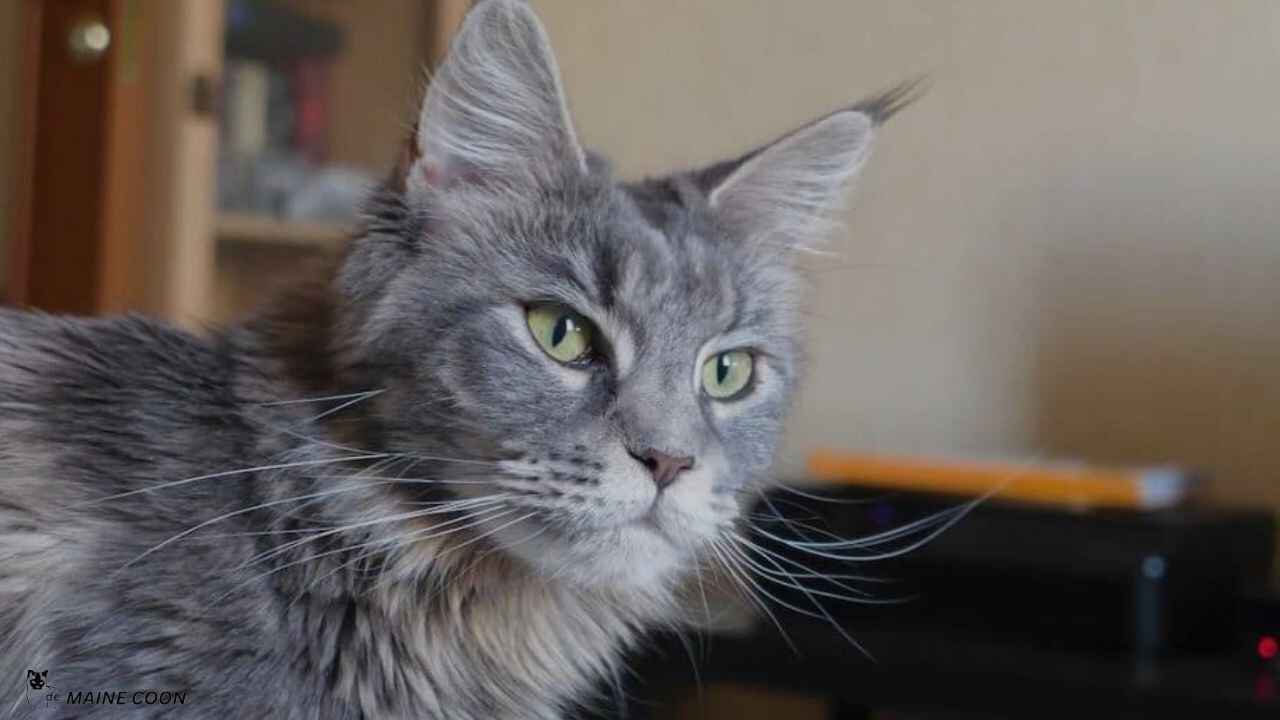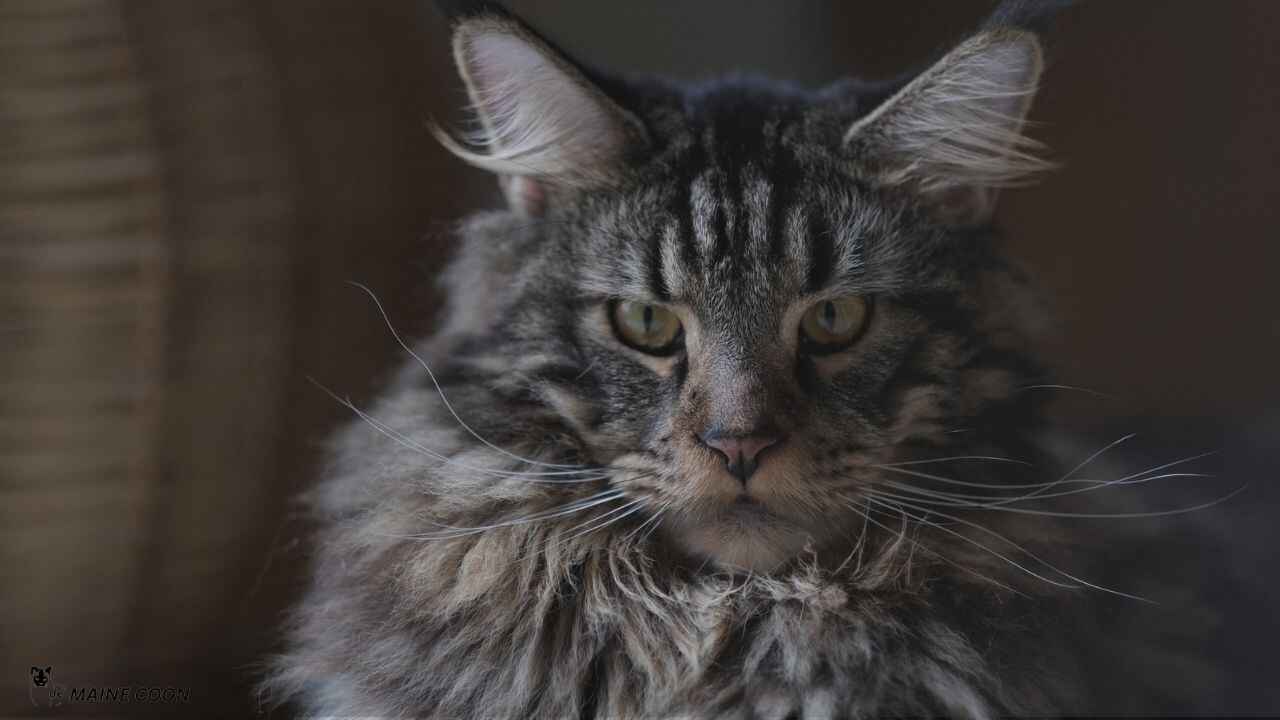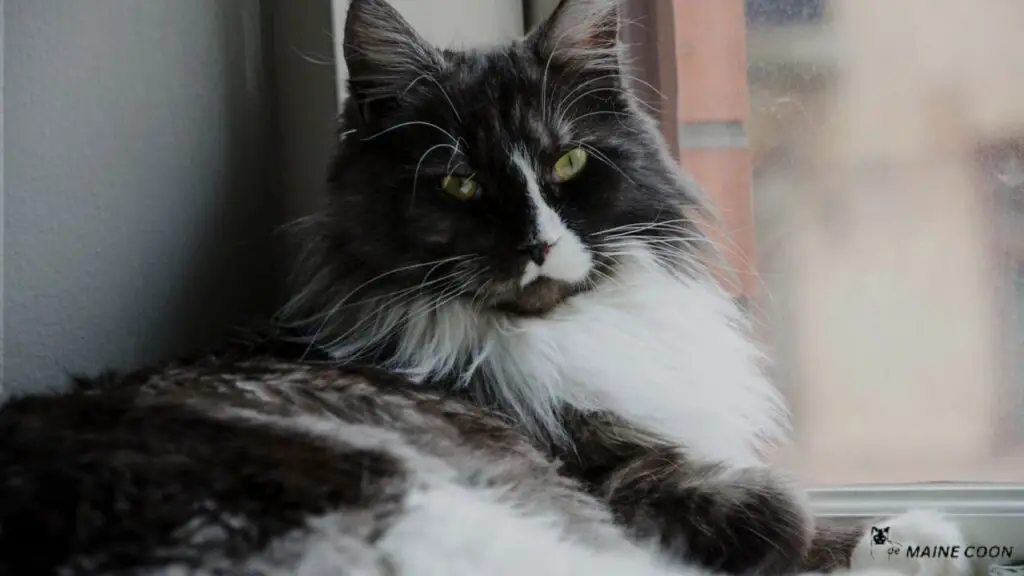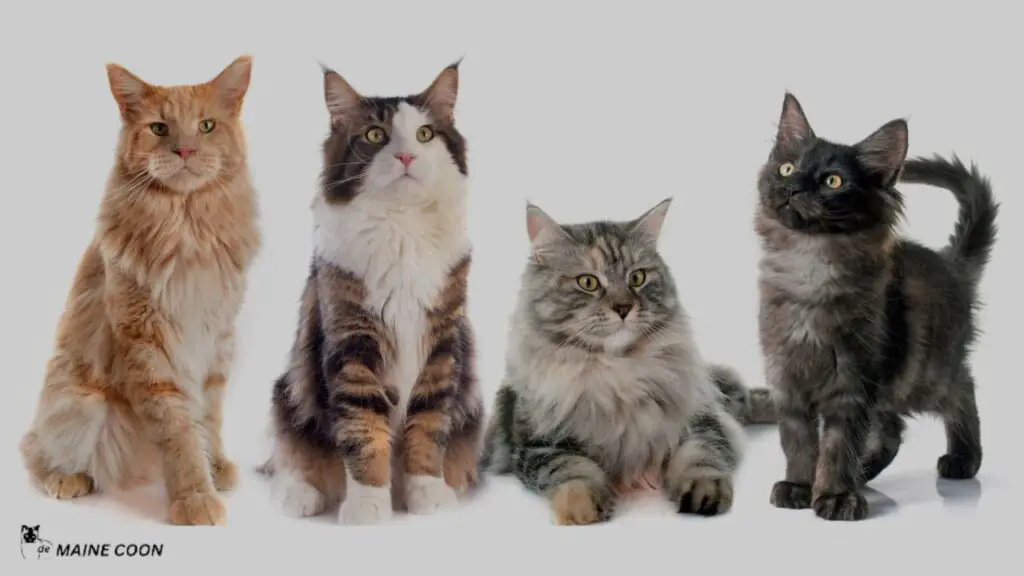Exploring Grey Maine Coon Cats: Colors, Origins, and Charms

Discover the allure of Grey Maine Coon Cats, known for their intelligence and affectionate nature. Explore their colors, origins, and popularity, along with the genetics behind their unique coat hues.
If you want a jolly and lively pet, a Gray Maine Coon cat might be a perfect choice. They’re smart, affectionate, and get along great with other pets. The Grey Maine Coon Cat is a devoted and affectionate companion, ideal for any family. With their intelligence and ability to be trained, they bring endless happiness and friendship. Intelligence and the ability to train a pet of a family bring endless happiness and friendship.
Maine coon are also bigger as compared to other cat breeds like Siamese or Persian, but still easy to handle for most folks. Maine Coon cats are really big. The biggest one still recorded is Ludo, which is 45.6 inches long from his head to his tail. These cats are nice to have as pets and come in different colors and patterns.
Is grey Maine coon truly grey? Sometimes people seem Maine coon grey. Sometimes it might be smoky or silver and might be mixed in. Others might have patches of white fur. Some are just completely grey. But worldwide associations may referred grey Maine coon as “blue”.
Facts, Origin & History
Back in the early 19th-century origin of grey Maine coon is traced to when they were first introduced. Originating from Maine, they were bred from a combination of European cats brought to the US by early settlers. The Grey Maine Coon Cat has big paws and thick fur because they were made to handle Maine’s cold weather. They are commonly used for hunting and guarding because of their intelligence and ease of training. But soon they are favored as pets due to their soft appearance and popularity.
Gene decides the color of the Maine coon cat. Their fur might be gray, white, blue, red, brown, orange, silver, black, or black smoke. Just like other Maine Coons, they also have long hair tufts on their ears tips to keep them warm. The grey type is most common and caused by a special dilution gene, giving them a beautiful silvery-grey color.
How Gray Maine Coon Cats Gained Popularity
Gray Maine Coon cats started to become popular at pet shows in the mid-1800s. People were attracted by their intelligence, beauty, and the ease of their training. Their affectionate and loyal personalities also made them favorites among people.
Understanding The Dilute Gene
Some cats may have a gene called the dilute gene, but not all cats have this. Even after having this gene, their coat color does not need to be diluted. The diluted coat color only shows up if the cat inherits two copies of the dilute gene, one from each parent. This occurs because the effect of the gene is recessive and rare.
The spread of melanin (pigment) in the cat’s fur is the effect of a dilute gene. Without this gene, cats have a consistent display of pigmentation throughout their fur. But those cats who inherit two copies of genes have uneven pigmentation and as a result, have patches without any pigment in many areas of their hair.
The diluted color appears because of microscopic clusters of pigments in some areas of the fur while other areas appear to have no pigment at all. These clusters are too small and when we look at them with naked eyes, the colors seem blended and diluted.
Why is a Grey Maine Coon Called a Blue Maine Coon?

People give many suggestions about why grey Maine Coon is called blue. One reason is that a particular dark grey shade may give a bluish tint. Since all grey is just a diluted black, darker greys may appear bluish. Another theory suggests that judges in cat show a shade of grey that looked like blue, which led to the term “blue” being used for gray Maine Coon.
These all are the suggestion proposed by people but in actuality, if you see any blue Maine coon it’s a black cat having two copies of the recessive gene for color. Other diluted colors include lilac, which comes from chocolate; fawn, which comes from cinnamon, and cream, which comes from red.
Blue Rare Maine Coon Cat
Grey or silver cats are sometimes called blue because their coats have a bluish appearance. This tint is subtle, similar to what military cadets wear. Cats with grey coats have diluted black coats genetically. As for why “blue” is used instead of “grey,” nobody knows for sure.
Blue is not the most ordinary color for Maine Coons. Black, cream, and white are more typical colors. However, solid blue Maine Coons do exist, although they are very rare. Maine Coons can come in over 85 different color combinations, making it hard to choose just one.
The Grey Maine Coon Kitten
Grey Maine Coon kittens are just as adorable as any other Maine coon. A solid grey one looks particularly innocent because it does not have markings on its face. However, don’t be fooled; it’s just as playful as any other kitten. While solid grey or dark grey Maine Coon kittens are rare, grey tabbies are more common and can be easily found.
You may also be interested in: Calico Maine Coon.
Maine Coon Color Classes
There are 30 different variations in color for grey Maine Coon, including solid grey and 29 other variations. Grey cats are usually called blue because their coats may have a bluish tint, caused by genetics making grey a diluted version of black. The Cat Fanciers’ Association (CFA) officially recognizes these colors, although they use “blue” instead of “grey.” This includes shades of silver, as they are a lighter form of grey.
When it comes to tabby patterns, there are three different possibilities:
- Classic (blotched) – This pattern has rings on the sides of the body and butterfly-like shapes over the shoulders.
- Mackerel (striped) – The most common pattern, with narrow stripes starting from a dark stripe along the backbone and running down towards the belly, resembles a fish skeleton.
- Ticked (agouti) – Each hair has multiple bands of color, with tabby rings on the legs and tail. It’s also referred to as the agouti or Abyssinian tabby pattern.
Following are the color shades:
| Solid Grey | Its fur is the same shade of grey from root to tip, with no variations in color across the cat’s body. |
| Silver Tabby | It has a light silver base color with dense black markings. It could be described as a Maine Coon with both black and grey colors. |
| Silver Patched Tabby | It has a light silver base color with dense black markings and patches of red and/or cream. |
| Grey Silver Tabby | It has a light silver base color with darker grey contrasting markings. |
| Grey Silver Patched Tabby | It has a light silver base with darker grey markings, along with patches of cream. It also features a white undercoat. |
| Grey Tabby | Grey Tabby Maine coon has a light ivory base color with deep grey tabby markings, and there’s a subtle layer of warm fawn tones throughout the coat. |
| Grey Patched Tabby | It may have a classic, mackerel, or ticked pattern. Its base color is a light ivory grey, with deep grey markings and patches of cream. The entire coat has subtle warm fawn tones throughout. |
| Silver Tabby and White | It has a light silver base color with deep grey markings, along with white areas on the bib, belly, and feet. |
| Silver Patched Tabby and White | It features a light silver base with deep grey markings and patches of cream. It has a white undercoat as well as white areas on the bib, belly, and feet. |
| White and Grey Tabby | White and Grey Tabby Maine coon features a base color of light ivory grey with very deep grey tabby markings. The coat also has subtle warm fawn tones throughout. Additionally, it has white areas on its bib, belly, and paws. |
| Grey Patched Tabby and White | It has a light ivory-grey base color with very deep grey markings and patches of cream. The coat also has subtle warm fawn tones throughout. Additionally, it features white areas on its bib, belly, and paws. |
| Grey and White | Grey and white Maine coon cat belongs to the bi-color category and has both grey and white fur. It also has white markings on its bib, belly, and paws. |
| Cream Grey | It falls into the parti-color category. It features grey fur with patches of cream or soft areas of cream across its body and extremities. |
| Cream Grey and White | Cream Grey and White Maine coon cat displays grey fur with patches of cream or soft cream areas on its body and extremities. Additionally, it has white markings on its bib, belly, and paws. |
| Chinchilla Silver | It has a pure white undercoat. Its back, sides, head, and tail fur have black tips, creating a sparkling silver look. The legs may have slight shading, while the chin, ear tufts, stomach, and chest are pure white. |
| Shaded Silver | It has a white undercoat with black tipping along its sides, face, and tail. The shading ranges from dark on the back to white on the chin, chest, stomach, and under the tail. Overall, it appears darker than a silver chinchilla. |
| Chinchilla Grey Silver | It has a white undercoat. Its back, sides, head, and tail fur are tipped with grey, creating a sparkling silver look. The legs may have slight shading, while the chin, ear tufts, stomach, and chest remain pure white. |
| Shaded Grey Silver | It has a white undercoat with grey tipping shading on its sides, face, and tail. This shading ranges from dark on the ridge to white on the chin, chest, stomach, and under the tail. Overall, it appears much darker than a silver chinchilla. |
| Shell Grey Cream | It features a white undercoat. Its back, sides, and tail fur are lightly tipped with grey and shades of cream. The face and legs may have light shading, while the chin, ear furnishings, stomach, and ruff can be white or lightly tipped with shading. |
| Shaded Grey Cream | It has a white undercoat with grey and cream shading along its sides, face, and tail. The face and legs may be darker than the rest of the body. Its chin, ear furnishings, stomach, and ruff can be white or lightly shaded. Overall, it appears much darker than the shell grey cream. |
| Grey Smoke | It has a white undercoat that’s heavily tipped with grey. When still, it appears solid grey, but as it moves, the white undercoat becomes visible, creating a smoky effect. It features grey points and a grey mask on its face, along with a white ruff and ear tufts. |
| Grey Cream Smoke | It has a white undercoat with deep grey tips and defined cream patches. It looks grey-cream when still, but as it moves, the white undercoat shows. Its face and ears have a grey-cream pattern with a narrow white band close to the skin. Additionally, it has a white ruff and ear tufts. |
| Chinchilla Silver and White | It has a white undercoat with black-tipped fur on its back, sides, head, and tail, creating a sparkling silver look. Its legs may have slight shading, while its chin, ear tufts, stomach, chest, bib, belly, and paws are pure white. |
| Shaded Silver and White | It has a white undercoat with black tipping along its sides, face, and tail. The shading ranges from dark on the ridge to white on the chin, chest, stomach, and under the tail, appearing darker than a chinchilla. It also features white on its bib, belly, and paws. |
| Chinchilla Grey Silver and White | It has a white undercoat with grey-tipped fur on its back, sides, head, and tail, creating a sparkling silver appearance. Its legs may have slight shading. Additionally, it has white markings on its chin, ear tufts, stomach, chest, bib, belly, and paws. |
| Shaded Grey Silver and White | It features a white undercoat with grey tipping shading along its sides, face, and tail. The shading ranges from dark to white, creating a darker effect than a silver chinchilla. Additionally, it has white on its bib, belly, and paws. |
| Shell Grey Cream and White | It features a white undercoat with lightly tipped grey and cream fur on its back, sides, and tail. Its face and legs may also have light shading. Additionally, its chin, ear furnishings, stomach, and ruff can be white or lightly shaded. It also has white markings on its bib, belly, and paws. |
| Shaded Grey Cream and White | It has a white undercoat with grey and cream shading along its sides, face, and tail. The face and legs may be darker than the body. Its chin, ear furnishings, stomach, and ruff may be white or lightly shaded. Overall, it appears much darker than the shell grey cream. Additionally, it has white markings on its bib, belly, and paws. |
| White and Grey Smoke | White and Grey Smoke Maine coon features a white undercoat with deep grey tipping, giving the appearance of solid grey when still. As it moves, the white undercoat becomes visible, creating a smoky effect. It has grey points and a mask on its face, along with white ruff, ear tufts, bib, belly, and paws. |
| Grey Cream Smoke and White | It has a white undercoat with deep grey tips and patches of cream. When still, it looks grey-cream, but when it moves, the white undercoat shows. Its face and ears have a grey-cream pattern with a narrow white band close to the skin. Additionally, it has white ruff, ear tufts, bib, belly, and paws. |
See Also: Smoke Maine Coon.
Grey Maine Coon Mix
The coat color in grey Maine Coon results from a dilute form of black, which requires two copies of the dilution gene. Hence, a grey Maine Coon carries two dilution genes. Breeding a purebred grey Maine Coon with another breed is equally feasible as breeding with any other Maine Coon color.
The coat color of mixed kittens from a grey Maine Coon will be determined by the other cat’s color and coat genetics, making predictions challenging due to the complexity of color genetics.
Price of Grey Maine Coon

Maine Coon cats are loved and adored because they’re friendly, playful, and great with families, especially kids. They’re known for being wonderful pets, which is why they’re so popular in the United States. But because they’re fancy pedigree cats, they tend to be pricer than regular cats. However, the extra amount you’d pay for a gray Maine Coon cat can differ depending on where you get it from.
| Age | Average Price | Average Price |
| Maine Coon Kitten | $1000 | £819 |
| Maine Coon Cat | $600 | £474 |
| ‘Show’ Maine Coon | Up to $2500 | Up to £1975 |
| Rescue Maine Coon | Varies | Varies |
If you want to buy a Maine Coon kitten, a grey Maine Coon kitten typically costs around $1000. But if you’re willing to adopt an older cat, the price drops to about $600. If you’re thinking of entering your cat into shows, be prepared to pay up to $2500 because breeding and training show cats make them more expensive. Keep in mind that while older cats might seem like a better deal, they could have health issues that could end up with significant veterinary expenses.
Conclusion
Maine Coons are loved for their friendly nature and big size, no matter their coat color. People often call them “grey,” but official groups say this grey-blue Maine coon is “blue”. Even though their color genes aren’t straightforward, grey Maine Coons often come in various shades, from silver to deep grey, making them special pets. While not all organizations formally recognize them as “grey,” these cats are still loved for their looks and personality, bringing joy to their owners’ lives.
Despite the official label, grey-blue Maine Coon is still super adorable. With their cool fur patterns and loving behavior, they make awesome pets, bringing happiness and warmth to any home. Their distinctive coloring just enhances their charm, making them prized pets for anyone who appreciates their special beauty and friendly ways.
You may also be interested in: Tuxedo Maine Coon.




